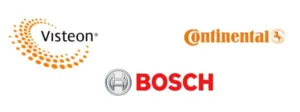At the 2016 WardsAuto User Experience Conference, held on October 4 in Novi, MI, USA, Visteon, Continental and Bosch discussed their plans for the future development of head up display (HUD) systems for the automotive industry. As major suppliers of complex car components we can assume that most of these developments are pursued together with car manufacturers.
Visteon said that they are working on an augmented reality based (AR) HUD that should be available in the market by 2020. It was not clear if this means they are offering this to car manufacturers by then or if AR HUDs will be available on cars in the market already. The key to an AR HUD is to mix AR content with standard HUD content (information, entertainment, navigation, etc.). In their vision, the lower part of the HUD will show the standard content used today and the upper portion will carry information like lane departure, adaptive cruise control, collision warning and enhanced navigation.
The key to making this work in real life is to change the viewing distance from the end of the car as it typically projected today to a focus plane further out to avoid focus / accommodation issues for the user. They are also developing a version where there are two focus planes in one installation. If the focus plane is moved far enough out, the parallax effect is reduced and the system may be able to work without an eye tracking system.
Continental is pursuing a similar strategy. Their focus is to develop an enhanced navigation system that would be able to direct the driver through multilane traffic as is often the case in larger cities. The direction to go straight is somewhat unclear if there are several turn only lanes on both sides of the street. An AR HUD that shows the driver exactly which lane to use would improve the confidence of the driver, reducing dangerous situations and improve driving safety.
While the AR HUD is on the roadmap, Continental will introduce a new HUD next year that is based on a DLP chip instead of an LCD. Prototypes of such a system were already shown at CES 2015 in the TI innovation suite.
Bosch is focusing its efforts on reducing the cost of HUDs to reach lower cost vehicles instead of the mid to high end luxury and sports cars that have been the main adopters of HUDs today. One example is the HUD for the BMW Mini, where they are using a combiner HUD with a dedicated optical combiner sheet instead of using the windshield. The windshield has a complex shape that makes the design of the HUD more expensive compared to a flat plastic sheet as used by Bosch.
Another area that Bosch sees as an important factor to improve driving safety is the introduction of a haptic feedback touch display. This gives the driver the feedback to find a touch “button” without looking at the display screen and taking their eyes of the road. This system was shown by Bosch on several occasions including at CES 2016. (NH)

